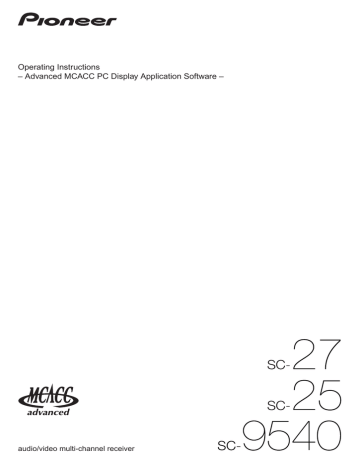About this manual. Pioneer SC-9540
Add to my manuals
36 Pages
Pioneer SC-9540: The SC-9540 redefines the home theater experience with its advanced sound calibration and immersive audio features. Its Full Auto MCACC (Multi-Channel Acoustic Calibration) system analyzes your room's acoustics and adjusts speaker levels and delays for optimal sound.
advertisement

About this manual
These are the Operating Instructions for an application which displays on your computer screen the listening room reverberation frequency characteristics, the speakers’ group delay characteristics and the
MCACC parameters measured by the Advanced MCACC function of your SC-27, SC-25 or SC-9540.
It explains everything you need to know to use the application, from installation to troubleshooting. You will need to operate the receiver to use this application, so please refer also to the Operating Instructions supplied with the receiver.
About the Advanced MCACC Application
The functions of the Advanced MCACC application are used with the same purpose as the “Reverb View” and “Group Delay” functions of the receiver itself (see pages 116 and 120 (SC-27, SC-25)/102 and 105 (SC-
9540) of the receiver’s Operating Instructions), namely to display the reverberation characteristics of the listening environment and the group delay characteristics of the speakers. Using a computer provides cleaner, more easily readable graphs. The application can also be used to display the measurement values stored in the receiver’s MCACC memory.
Requirements for using the application on your PC
• The computer must be a PC functioning with one of the following operating systems: Microsoft
Windows ® Vista Home Basic/Home Premium/Ultimate SP1, Windows ®
®
XP Professional/Home Edition
SP3 or Windows
®
2000 Professional SP4.
• The monitor must have a display resolution of 800 x 600 dots (SVGA) or greater.
• An RS-232C port connector is necessary for graphical output. Refer to the PC’s operating instructions and/or the PC manufacturer for more information on making the proper port settings.
Microsoft
®
, Windows
®
Vista, Windows
®
XP and Windows
®
2000 are either registered trademarks or trademarks of
Microsoft Corporation in the United States and/or other countries.
Main features of the application
1. Displays 3D graphs of the reverberation frequency characteristics of your room. You can choose to see these measurements both with and without the equalization performed by this receiver (before and after calibration).
2. Allows you to display 3D graphics of the group delay characteristics of the different speakers. (The values before and after calibration can be displayed.)
3. Allows you to display a list of the Advanced MCACC parameters (the results of measurements).
4. Allows you to view graphs in a number of different formats.
5. Allows you to save the various measured data on the computer.
6. Allows you to make memos about the conditions in your room when you made the measurements, etc.
7. Allows you to print the various graphs and the MCACC measurement values.
2
About the Advanced MCACC Application (Continued)
Things you can accomplish with this application
1. Advanced EQ Setup, which you can do with the receiver (see page 116 (SC-27, SC-25)/102 (SC-
9540) of the receiver’s Operating Instructions), allows you to choose the optimum time period for auto EQ setup. You can use this application’s reverberation characteristics (Reverb) as a guide in choosing the best time period for your room.
For details, see Deciding the time period for Advanced EQ Setup calibration (page 19) .
2. Skewed reverb frequency characteristics in your listening room can prevent you from enjoying an accurate sound field. The graphs displayed by this application are a powerful tool because they allow you to check these reverb frequency characteristics at a glance. You can also check the effectiveness of steps that you take to improve the acoustics of your listening room, for example, installing sound absorbent material.
For details, see Checking steps to improve your room’s reverb characteristics (page 21)
.
3. The reverb characteristics after calibration can be displayed. This lets you to check the EQ effects of the Advanced MCACC measurements you have made.
For details, see About the display of the reverb characteristics graphs before and after calibration
4. The Group Delay graphs allow you to check the group delay characteristics before and after calibration.
For details, see Reading the group delay characteristics graph (Group Delay) (page 25) .
5. The MCACC parameter display (Parameters) allows you to display on the computer all the parameters (measurement values) stored in the receiver’s MCACC memories.
For details, see Display of the MCACC parameters (page 26) .
3
advertisement
* Your assessment is very important for improving the workof artificial intelligence, which forms the content of this project
Related manuals
advertisement
Table of contents
- 2 About this manual
- 2 About the Advanced MCACC Application
- 2 Requirements for using the application on your PC
- 2 Main features of the application
- 3 Things you can accomplish with this application
- 4 Installing the Application
- 7 Operations on the Receiver and Cable Connections
- 9 Applications Operations
- 9 Receiving measurement data
- 11 Graph and parameter displays (names and functions of parts)
- 16 Saving graphs in data files
- 17 Opening data files
- 17 Exiting the application
- 18 How to Interpret the Graphs
- 18 How to interpret reverb graphs (Reverb)
- 19 Deciding the time period for Advanced EQ Setup calibration
- 21 Checking steps to improve your room’s reverb characteristics
- 23 About the display of the reverb characteristics graphs before and after calibration
- 24 About the types of displays of the graph for the reverb characteristics after EQ calibration
- 25 Reading the group delay characteristics graph (Group Delay)
- 26 Display of the MCACC parameters
- 26 Parameters that can be displayed
- 26 Displays of the different memories
- 27 Updating, Deleting and Repairing the Application
- 27 Updating the application
- 28 Deleting the application
- 30 Repairing the application
- 31 Modifying the application
- 32 Troubleshooting